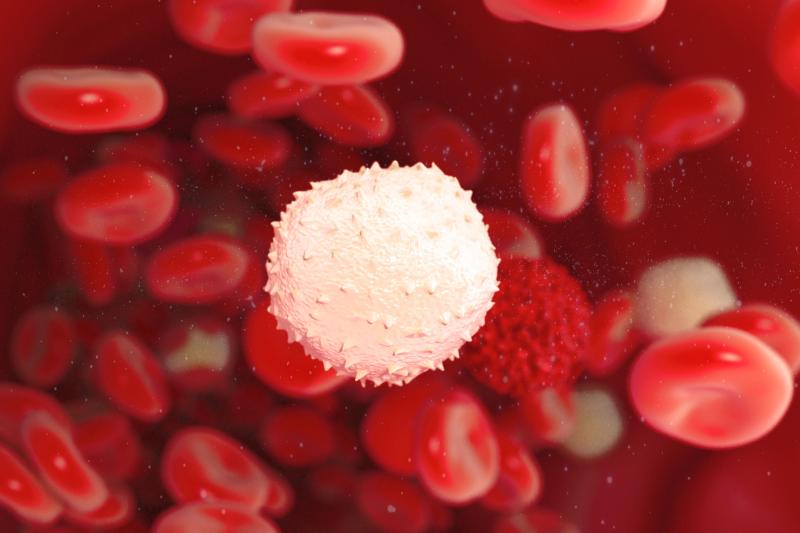
The combination of venetoclax with bortezomib and dexamethasone (Bd) significantly improves response rates in patients with relapsed/refractory multiple myeloma (RRMM), although survival, according to updated results of the BELLINI* study presented at ASH 2019.
“Venetoclax is a highly selective, potent, oral BCL-2** inhibitor that induces apoptosis in MM cells and has shown synergistic activity with the proteasome inhibitor Bd,” said the researchers.
This phase III, multicentre, double-blind trial evaluated 291 patients (median age 66 years) with RRMM who were sensitive or naive to bortezomib and had 1–3 lines of prior therapy. Participants were randomized in a 2:1 ratio to receive either venetoclax 800 mg daily + Bd*** (n=194) or placebo + Bd (n=97). [ASH 2019, abstract 1888]
Significantly more patients treated with venetoclax + Bd demonstrated an improved overall response rate (84 percent vs 70 percent; p=0.013), with very good partial response (62 percent vs 40 percent; p<0.001) and complete response rates (30 percent vs 7 percent; p<0.001) compared with placebo + Bd.
Patients on venetoclax + Bd also achieved minimal residual disease (MRD)-negative status at cut-offs of <10-4 (21 percent vs 4 percent; p<0.001), <10-5 (15 percent vs 2 percent; p=0.002), and <10-6 (8 percent vs 1 percent; p=0.037) than those on placebo + Bd.
The median duration of response was significantly longer in the venetoclax + Bd arm at 26.7 months vs the placebo + Bd arm at 12.8 months (hazard ratio [HR], 0.533, 95 percent confidence interval [CI], 0.364–0.781; p<0.001).
As per the investigator’s assessment, patients who received venetoclax + Bd experienced a significantly longer progression-free survival (PFS) than those who had placebo + Bd (median, 23.2 vs 11.4 months; HR, 0.601, 95 percent CI, 0.437–0.825; p=0.001).
However, a higher rate of death was observed in the venetoclax + Bd arm compared with the placebo + Bd arm (30 percent vs 25 percent), with a median overall survival (OS) favouring the placebo + Bd arm than the venetoclax + Bd arm (not reached vs 32.5 months; HR, 1.317, 95 percent CI, 0.818–2.122; p=0.256).
Fourteen treatment-emergent deaths were reported in the venetoclax + Bd arm and one in the placebo + Bd arm. Infection was found to be the primary cause of death, which was higher in the venetoclax + Bd vs placebo + Bd arms (n=18 vs n=2), and progressive disease was also higher in the venetoclax + Bd than the placebo + Bd arms (n=26 vs n=17).
The most common grade 3/4 adverse events (AEs) reported in the venetoclax + Bd vs placebo + Bd groups were neutropenia (21 percent vs 8 percent), thrombocytopenia (15 percent vs 30 percent), anaemia (16 percent vs 15 percent), diarrhoea (15 percent vs 11 percent), and pneumonia (18 percent vs 13 percent). Serious AEs occurred in 103 patients in the venetoclax + Bd arm and 49 patients in the placebo + Bd arm.
“The addition of venetoclax to Bd significantly improved PFS, clinical response, and MRD negativity rates in patients with RRMM … [However,] an increase in deaths was still observed with venetoclax + Bd compared with placebo + Bd [arms],” the researchers concluded.
Nonetheless, in a subgroup analysis of patients with MM positive for t(11;14) status (n=35) or high levels of BCL2 (BCL2high) gene expression (n=140), those treated with venetoclax + Bd vs placebo + Bd showed a more favourable PFS (HR, 0.09 or HR, 0.52) and OS (HR, 0.68 or HR, 1.29).
“Patients with t(11;14) or BCL2high gene expression had consistent clinical benefit when treated with venetoclax + Bd regardless of other high-risk features, and the benefit-risk profile appears to be favourable in these MM subsets,” noted the researchers, who added that “the BELLINI study results support a biomarker-driven approach for the development of venetoclax in the t(11;14) and BCL2high gene expression MM subgroups.”
*BELLINI: A study evaluating venetoclax (ABT-199) in multiple myeloma subjects who are receiving bortezomib and dexamethasone as standard therapy
**BCL-2: B-cell lymphoma 2
***Dosage: For cycles 1–8 (21-day, B=1.3 mg/m2 for days 1, 4, 8, and 11 and d=20 mg for days 1, 2, 4, 5, 8, 9, 11, and 12) and cycles 9+ (35-day, B=1.3 mg/m2 for days 1, 8, 15, and 22 and d=20 mg for days 1, 2, 8, 9, 15, 16, 22, and 23)